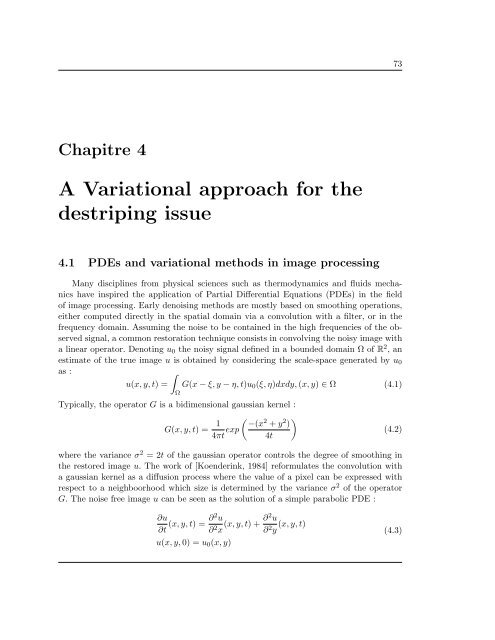Th`ese Marouan BOUALI - Sites personnels de TELECOM ParisTech
Th`ese Marouan BOUALI - Sites personnels de TELECOM ParisTech
Th`ese Marouan BOUALI - Sites personnels de TELECOM ParisTech
Create successful ePaper yourself
Turn your PDF publications into a flip-book with our unique Google optimized e-Paper software.
73<br />
Chapitre 4<br />
A Variational approach for the<br />
<strong>de</strong>striping issue<br />
4.1 PDEs and variational methods in image processing<br />
Many disciplines from physical sciences such as thermodynamics and fluids mechanics<br />
have inspired the application of Partial Differential Equations (PDEs) in the field<br />
of image processing. Early <strong>de</strong>noising methods are mostly based on smoothing operations,<br />
either computed directly in the spatial domain via a convolution with a filter, or in the<br />
frequency domain. Assuming the noise to be contained in the high frequencies of the observed<br />
signal, a common restoration technique consists in convolving the noisy image with<br />
a linear operator. Denoting u 0 the noisy signal <strong>de</strong>fined in a boun<strong>de</strong>d domain Ω of R 2 , an<br />
estimate of the true image u is obtained by consi<strong>de</strong>ring the scale-space generated by u 0<br />
as :<br />
∫<br />
u(x, y, t) = G(x − ξ, y − η, t)u 0 (ξ, η)dxdy, (x, y) ∈ Ω (4.1)<br />
Ω<br />
Typically, the operator G is a bidimensional gaussian kernel :<br />
G(x, y, t) = 1 ( −(x 2<br />
4πt exp + y 2 )<br />
)<br />
4t<br />
(4.2)<br />
where the variance σ 2 =2t of the gaussian operator controls the <strong>de</strong>gree of smoothing in<br />
the restored image u. The work of [Koen<strong>de</strong>rink, 1984] reformulates the convolution with<br />
a gaussian kernel as a diffusion process where the value of a pixel can be expressed with<br />
respect to a neighboorhood which size is <strong>de</strong>termined by the variance σ 2 of the operator<br />
G. The noise free image u can be seen as the solution of a simple parabolic PDE :<br />
∂u<br />
∂t (x, y, t) u<br />
=∂2 ∂ 2 x (x, y, u<br />
t)+∂2 ∂ 2 (x, y, t)<br />
y<br />
u(x, y, 0) = u 0 (x, y)<br />
(4.3)















